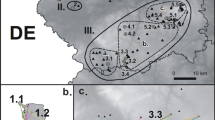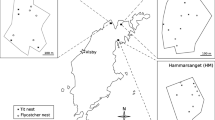Abstract
We investigated the metapopulation genetic structure of two specialist parasitoids, Cotesia melitaearum and Hyposoter horticola, attacking the Glanville fritillary butterfly (Melitaea cinxia) in the Åland Islands south-western Finland. The host butterfly persists as a classic metapopulation in a network of 4,000 small habitat patches within an area of 50 by 70 km . The two parasitoids are known to differ greatly in their population dynamics and spatial pattern of occupancy in local host populations. Analysis of genetic population structure using F ST and clustering of multilocus genotypes revealed a distinct large-scale spatial structure in C. melitaearum but a very weak pattern in H. horticola. This result is consistent with the known difference in the dispersal range (much longer in H. horticola) and population size (much greater in H. horticola) of the two parasitoids.




Similar content being viewed by others
References
Althoff DM, Thompson JN (1999) Comparative geographic structures of two parasitoid–host interactions. Evolution 53:818–825
Althoff DM, Thompson JN (2001) Geographic structure in the searching behaviour of a specialist parasitoid: combining molecular and behavioural approaches. J Evol Biol 14:406–417
Baker DA, Loxdale D, Edwards OR (2003) Genetic variation and founder effects in the parasitoid wasp, Diaeretiella rapae (M’intosh) (Hymenoptera: Braconidae: Aphidiidae), affecting its potential as a biological control agent. Mol Ecol 12:3303–3311
Bohonak AJ (1999) Dispersal, gene flow and population structure. Q Rev Biol 74:21–45
Chapman RE, Wang J, Bourke AFG (2003) Genetic analysis of spatial foraging patterns and resource sharing in bumblebee pollinators. Mol Ecol 12:2801–2808
Costa JT, McDonald JH, Pierce N (1996) The effect of ant association on the population genetics of the Australian butterfly Jalmenus evagoras (Lepidoptera: Lycaenidae). Biol J Linn Soc 58:287–306
Ehrlich PR, Hanski I (eds) (2004) On the wings of checkerspots: a model system for population biology. Oxford University Press, Oxford
Goudet J (2001) FSTAT, a program to estimate and test gene diversities and fixation indices (version 2.9.3). Available from http://www.unil.ch/izea/softwares/fstat.html
Goudet J, Raymond M, Demeeus T, Rousset F (1996) Testing differentiation in diploid populations. Genetics 144:1933–1940
Hanski I (1999) Metapopulation ecology. Oxford University Press, Oxford
Hanski I, Ovaskainen O (2000) Metapopulation capacity of a fragmented landscape. Nature 404:755–758
Hanski I, Moilanen A, Pakkala T, Kuussaari M (1996) The quantitative incidence function model and persistence of an endangered butterfly metapopulation. Conserv Biol 10:578–590
Hanski I, Hellmann JJ, Boggs CL, McLaughhlin JF (2004) Checkerspots as a model system in population biology. In: Ehrlich PR, Hanski I (eds) On the wings of checkerspots: a model system for population biology. Oxford University Press, Oxford, pp 245–263
Harrison S, Hastings A (1996) Genetic and evolutionary consequences of metapopulation structure. Trends Ecol Evol 11:180–183
Ingram KK, Gordon DM (2003) Genetic analysis of dispersal dynamics in an invading population of argentine ants. Ecology 84:2832–2842
Jensen MK, Kester KM, Kankare M, Brown BL (2002) Characterization of microsatellite loci of parasitoid, Cotesia congregata (Say) (Hymenoptera). Mol Ecol Notes 2:346–348
Johannesen J, Seitz A (2003) Comparative population genetic structures of the fruit fly Urophora cardui and its primary parasitoid Eurytoma robusta. Entomol Exp Appl 108:149–157
Kankare M, Shaw MR (2004) Molecular phylogeny of Cotesia (Hymenoptera: Braconidae: Microgastrinae) parasitoids associated with Melitaeini butterflies (Lepidoptera: Nymphalidae: Melitaeini). Mol Phyl Evol 32:207–220
Kankare M, Jensen MK, Kester KM, Saccheri IJ (2004a) Characterization of microsatellite loci in two primary parasitoids of the butterfly Melitaea cinxia, Cotesia melitaearum and Hyposoter horticola (Hymenoptera). Mol Ecol Notes 4:231–233
Kankare M, Stefanescu C, van Nouhuys S, Shaw MR (2004b) Host specialization by Cotesia wasps (Hymenoptera: Braconidae) parasitising species-rich Melitaeini (Lepidoptera: Nymphalidae) communities in north-eastern Spain. Biol J Linn Soc (in press)
Kraushaar U, Goudet J, Blanckenhorn WU (2002) Geographical and altitudinal population genetic structure of two dung fly species with contrasting mobility and temperature preference. Heredity 89:99–106
Lei GC, Camara MD (1999) Behaviour of a specialist parasitoid, Cotesia melitaearum: from individual behavior to metapopulation processes. Ecol Entomol 24:59–72
Lei GC, Hanski I (1997) Metapopulation structure of Cotesia melitaearum, a specialist parasitoid of the butterfly Melitaea cinxia. Oikos 78:91–100
Lei GC, Hanski I (1998) Spatial dynamics of two competing specialist parasitoids in a host metapopulation. J Anim Ecol 67:422–433
Lei GC, Vikberg V, Nieminen M, Kuussaari M (1997) The parasitoid complex attacking the Finnish populations of Glanville fritillary Melitaea cinxia (Lep: Nymphalidae), an endangered butterfly. J Nat Hist 31:635–648
Manel S, Schwarz MK, Luikart G, Taberlet P (2003) Landscape genetics: combining landscape ecology and population genetics. Trends Ecol Evol 18:189–197
Mantel N (1967) The detection of disease clustering and a generalized regression approach. Cancer Res 27:209–220
Massonnet B, Simon J-C, Weisser WW (2002) Metapopulation structure of the specialist herbivore Macrosiphoniella tanacetaria (Homoptera, Aphididae). Mol Ecol 11:2511–2521
Molbo D, Machado CA, Herre EA, Keller L (2004) Inbreeding and population structure in two pairs of cryptic fig wasp species. Mol Ecol (in press)
Morehead SA, Seger J, Feener DHJ, Brown BV (2001) Evidence for a cryptic species complex in the ant parasitoid Apocephalus paraponerae (Diptera: Phoridae). Evol Ecol Res 3:273–284
Nei M (1987) Molecular evolutionary genetics. Columbia University Press, New York
Nieminen M, Siljander M, Hanski I (2004) Structure and dynamics of Melitaea cinxia metapopulations. In: Ehrlich PR, Hanski I (eds) On the wings of checkerspots: a model system for population biology. Oxford University Press, Oxford, pp 63–91
Pannell JR, Charlesworth B (2000) Effects of metapopulation processes on measures of genetic diversity. Philos Trans R Soc Lond B 355:1851–1864
Pritchard JK, Stephens M, Donnelly P (2000) Inference of population structure using multilocus genotype data. Genetics 155:945–959
Raymont M, Rousset F (1995) GENEPOP (version 1.2): population genetics software for exact tests and ecumenicism. J Hered 86:248–249
Roderick GK (1996) Geographic structure of insect populations: gene flow, phylogeny, and their uses. Annu Rev Entomol 41:325–352
Roslin T (2001) Spatial population structure in a patchily distributed beetle. Mol Ecol 10:823–837
Saccheri I, Boggs C, Hanski I, Ehrlich P (2004) Genetics of checkerspot populations. In: Ehrlich PR, Hanski I (eds) On the wings of checkerspots: a model system for population biology. Oxford University Press, Oxford, pp 199–218
Sanetra M, Crozier RH (2003) Patterns of population subdivision and geneflow in the ant Nothomyrmecia macrops reflected in microsatellite and mitochondrial DNA markers. Mol Ecol 12:2281–2295
van Nouhuys S, Ehrnsten J (2004) Wasp behavior that leads to uniform parasitism of a host available only a few hours per year. Behav Ecol 15:661–665
van Nouhuys S, Hanski I (1999) Host diet affects extinctions and colonizations in a parasitoid metapopulation. J Anim Ecol 68:1–12
van Nouhuys S, Hanski I (2002a) Colonisation rates and distances of a host butterfly and two specific parasitoids in a fragmented landscape. J Anim Ecol 71:630–650
van Nouhuys S, Hanski I (2002b). Multitrophic interactions in space: metacommunity dynamics in fragmented landscapes . In: Tscharntke T, Hawkins BA (eds) Multitrophic level interactions. Cambridge University Press, Cambridge, pp 124–147
van Nouhuys S, Hanski I (2004). Natural enemies of checkerspot butterflies. In: Ehrlich PR, Hanski I (eds) On the wings of checkerspots: a model system for population biology. Oxford University Press, Oxford, pp 161–180
van Nouhuys S, Tay WT (2001) Causes and consequences of mortality in small populations of a parasitoid wasp in a fragmented landscape. Oecologia 128:126–133
Vaughn TT, Antolin MF (1998) Population genetics of an opportunistic parasitoid in an agricultural landscape. Heredity 80:152–162
Weir BS, Cockerham CC (1984) Estimating F-statistics for the analysis of population structure. Evolution 38:1358–1370
Whitlock MC (2004) Selection and drift in metapopulations. In: Hanski I, Gaggiotti OE (eds) Ecology, genetics and evolution of metapopulations. Elsevier, Academic Press, Amsterdam, pp 153–174
Acknowledgements
We thank Toshka Nyman for help in the laboratory. We are grateful to G. -C. Lei for collecting some of the C. melitaearum and H. horticola samples. We thank Ilik Saccheri for his comments on the manuscript and Evgeniy Meyke for preparing the maps in Fig. 1. This study has been supported by the Academy of Finland (grant nos. 38604 and 44887 to Ilkka Hanski, Finnish Centre of Excellence Programme, 2000–2005).
Author information
Authors and Affiliations
Corresponding author
Rights and permissions
About this article
Cite this article
Kankare, M., van Nouhuys, S., Gaggiotti, O. et al. Metapopulation genetic structure of two coexisting parasitoids of the Glanville fritillary butterfly. Oecologia 143, 77–84 (2005). https://doi.org/10.1007/s00442-004-1782-1
Received:
Accepted:
Published:
Issue Date:
DOI: https://doi.org/10.1007/s00442-004-1782-1




